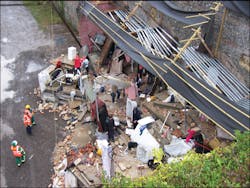Massive USAR Drill Simulates Earthquake Damage Throughout UK
Exercise Orion 2010 took place during September at various locations across England. It was centered on an earthquake scenario which was designed to simulate an event that has a very low likelihood in the United Kingdom (UK) and therefore is outside all normal planning assumptions. The exercise concept is that this is "training for reality" and not a showcase. The UK has a highly developed, well coordinated and practiced response to resolving incidents. This exercise provided another avenue to share experiences with all participants.
Urban search and rescue (USAR) teams from the UK were joined by teams from the European Union and a team from the United Arab Emirates during this exercise.
The main field exercises were held on two sites outside of Portsmouth, England. Fort Widley was home to the primary field exercise activities. This Napoleonic-era facility is regularly used by members of the Hampshire Fire and Rescue Service (FRS) USAR. Multiple scenario locations were created for this exercise. To prepare for this massive event members of the Hampshire FRS/USAR team spent over four months developing the site by both constructing new challenges and updating and modifying existing locations within the complex.
In addition to the Fort Widley site they utilized an adjacent facility nearby. This location consisted of a multi-story building currently under demolition. This challenged not only the rescue specialist working on the ground, but the logistics components of the teams were also put to the test by having multiple locations to support during the exercise.
The exercise started with a simulated earthquake which triggered the response of over 20 units from the Hampshire FRS. These companies were met by exercise staff members and role players in a manner that mirrored a Hollywood production. The level of realism created by the Hampshire FRS staff immediately challenged the first responders and set the stage for the following three days of activity.
The first challenge faced was the "Widley Cliff Apartments," consisting of exterior and interior challenges. The "North Block" rubble pile had numerous casualties including, uninjured hurt but dazed and injured surface casualties, lightly trapped, heavily trapped and deeply hidden victims. The many passageways in the fort provided means to create safe havens and access points for victims to be placed inside of the "collapsed structure" and for exercise staff to constantly monitor the operations of the rescue teams and the safety of all exercise participants.
Many of the rescuers skills were challenged by the exercise development team. Rope access was needed to climb down to damaged roof structures then vertical rope access down to internal apartments areas. The pancake collapse required breaching and breaking skills along with shoring and monitoring to create safe havens for rescue operations.
The next area that rescuers came upon was known as "Widley Gorge Bridge East" and "West." The collapsed bridge offered a variety of challenges. A van pulling a camper was overturned with the camper hanging over the edge of the embankment. (All designed with hidden safety cables to provide for staff and rescuer safety during the exercise). Cars were scattered about on the bridge surface all with simulated victims playing their roles to the fullest, which taxed the most seasoned responder. Located below the bridge was a section of engineered concrete slabs representing the collapsed road surface. This component covered four trapped vehicles and tons of rubble, all designed with access for victims and exercise staff via passageways from the interior of the fort. The rescue teams objectives included: breaching the road surface, tunneling to the victims, and then assessing the victim's condition prior to packaging them for removal.
All of the props utilized during the exercise had been designed to be reset by exercise staff, thus allowing an endless volume of scenario locations for all of the exercise participants. This capability provided all participants realistic challenges during the four days of activity, during which time there was a 48 hour period of continuous operations.
Program Participants
Coordination of all resources of the USAR component was monumental. The exercise began with over 20 units from Hampshire FRS responding to the incident. Once the magnitude of the incident was identified additional UK USAR resources were summoned to the scene. As the event escalated the need for additional assistance was transmitted. USAR teams from Germany, United Kingdom, Italy, Norway, Sweden and the United Arab Emirates participated in this exercise.
Once on scene, these teams worked in real time conditions and were often called upon to respond to various exercise scenarios during their time on site. Most of the teams utilized this event as a "full operational test" while others were testing "light equipment deployment." Modes of transportation varied from team to team as well as the team's ability to self sustain.
While many of the teams were 100 percent self-sufficient, others required assistance with team and equipment movement which provided a real time test of the UKs ability to receive outside help while managing a major incident in their home communities. Teams provide their own housing/encampments or base of operations (BoO) at one centralized location. An overnight tent city was set up on what was the concrete foundation and surrounding lawn area of a recently demolished structure.
The exercise was also monitored by a team of evaluators whose mission was to observe and evaluate the interaction of the various teams deploying with the UK system. Evaluators came from a number of European Union countries and received training through the Netherlands Institute of Safety Nibra. The "Emergency Program Manager Master Class for Evaluators" was used to prepare the evaluators for this exercise. The advanced training created a well organized and functionally efficient team in the field. This training program is based on four basic principles: " Certified evaluators have learn how to observe in an objective manner, how to apply the correct methods and how to make adequate diagnosis, " Certified evaluators are able to make clear evaluations by choosing the right words when giving their feedback, " Certified evaluators are capable of writing clear evaluation reports with a purposeful text structure " Certified evaluators are able to conduct themselves in a professional manner and respond as an authority in conflict management.
In addition to this week-long training a one day short course was provided for tactical evaluators from the USAR community who operated in direct proximity of the responding team. This training provided a consistent evaluation process to the entire exercise.
Exercise participants came from multiple agencies. There were large numbers of EMS and law enforcement personnel in every aspect of the exercise.
EMS Hazardous Area Response Teams (HART) worked side by side with USAR teams evaluating patients and assisting in patient packaging and removal efforts. Post September 11, the National Health Service has funded each regional ambulance service to train and equip paramedics to wear breathing apparatus and join firefighters in the hot zone to stabilize trapped casualties. The value of having pre-trained members of the EMS community capable of working side-by-side with USAR personnel in the rescue effort was well identified during this exercise.
Law enforcement was actively involved with victim identification through the work of the Disaster Victim Identification (DVI) teams. These teams were tasked with marking victim locations using sophisticated GPS systems. Police teams were also called upon to find evidence related to exercise scenario-based crime scenes. One challenge placed upon the police teams was the recovery of a knife (a possible crime scene item) from a flooded crypt inside the walls of the fort. This situation created a need for USAR, police technicians and police SCUBA personnel to work together to complete the given tasks.
Exercise Management Framework
The UK utilized a system similar to the incident command system used in the United States. Their system is designed to manage incidents involving a large number of agencies that need to cooperate and support each other. Having a defined system ensures that all agencies understand their roles and responsibilities in the combined response.
Within this framework, the management of the emergency response and recovery effort is undertaken at one or more of three ascending levels which are defined by the differing functions rather than by specific rank, grade or status:
- Bronze -Operational Level - the level at which the management of immediate "hands-on" work is carried out. "
- Silver - Tactical level - the purpose of the silver level is to ensure that the actions taken by bronze are coordinated, coherent and integrated in order to achieve maximum effectiveness and efficiency. Usually comprised of the most senior officers of each agency committed within the area of operations and will assume tactical command of the event or situation.
- Gold - Strategic Level - also known as the Strategic Coordination Group (SCG). This level is established during events that have an especially significant impact or substantial resource implications, involving a large number of organizations or last for an extended duration. The SCG is to take overall responsibility for the multi-agency management of the emergency and to establish the policy and strategic framework within which silver will work.
All three levels of command were established for this exercise. At each level challenges were placed on the exercise participant and the decisions made were constantly being evaluated by the exercise staff. Assistant Chief Fire Officer Roy Harold summed up this process by stating "a drill only serves its purpose if you can learn from it. And to learn from it, you need to evaluate." Using this mindset at all levels of command provides a realistic view of just where your capabilities stand and where you need and/or want to be.
The exercise closed with the same intensity that it had begun with. A simulated aftershock was staged to signify the end of the exercise. Even as the event closed participants were faced with one last challenge, bringing four days of activity to completion.
Participants, evaluators and staff all left the exercise site with many memories of challenges faced and overcome. Exercise Orion 2010 will be remembers as a great success and as an event that lived up to its vision of "training for reality".
BOB DUEMMEL, a Firehouse.com and Firehouse Magazine Contributing Editor, is the host of "The Buzz on Technical Rescue" on Firehouse Podcasts. He is captain of the Special Operations Unit of the Rochester, NY, Fire Department and serves as the Plans Manager for NY TF-2. He is a member of the NYS USAR IST in the Operations Section and a member of the New York State Technical Rescue curriculum development team. He has delivered training to fire service, industrial, military and international rescue teams and has assisted with exercise evaluation for the United Kingdom and the European Union's USAR program. View all of Bob's articles and podcasts here. He can be reached via e-mail at [email protected].
About the Author
Bob Duemmel
Bob Duemmel was the technical rescue editor for Firehouse Magazine and Firehouse.com. A deputy coordinator for Special Operations in Monroe County, NY he recently retired as a captain with the City of Rochester Fire Department. Bob's involvement in technical rescue is very diverse. He is the Plans Manager for New York Task Force-2 USAR Team, a member of the Western New York Incident Management Team and a member of the New York State Technical Rescue curriculum development team. He is a nationally certified instructor with a focus on technical rescue programs. He has delivered training to fire service, industrial, military and international rescue teams and has assisted with exercise evaluation for the United Kingdom and the European Union's USAR program. Bob has also participated in numerous USAR exercised as both a participant and evaluator. He hosted “The Buzz on Technical Rescue” podcast.

